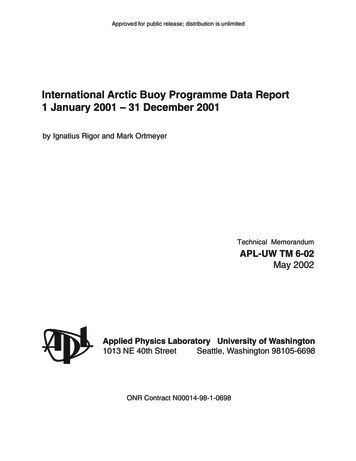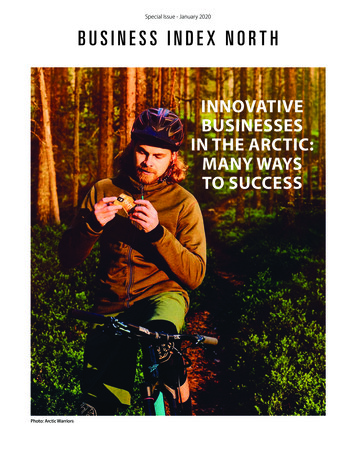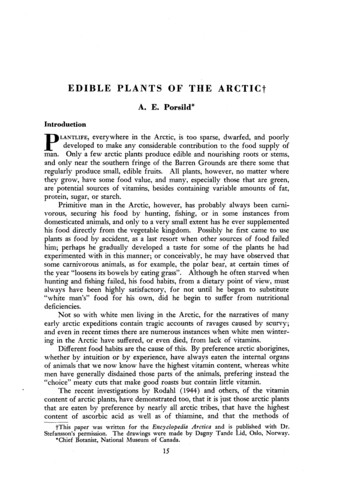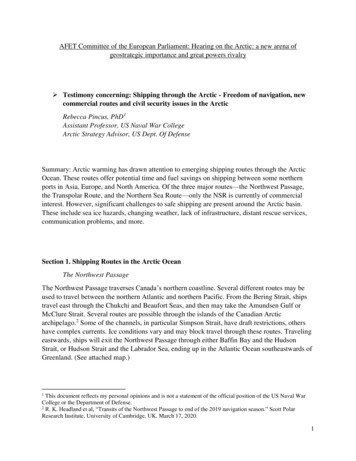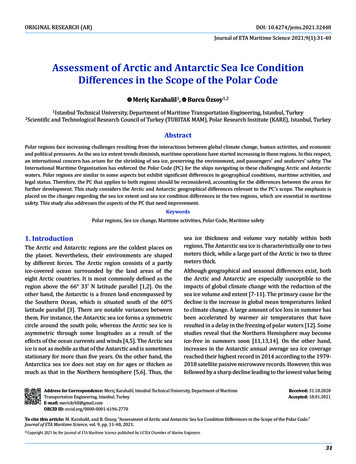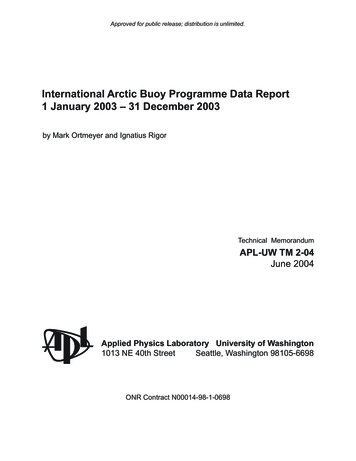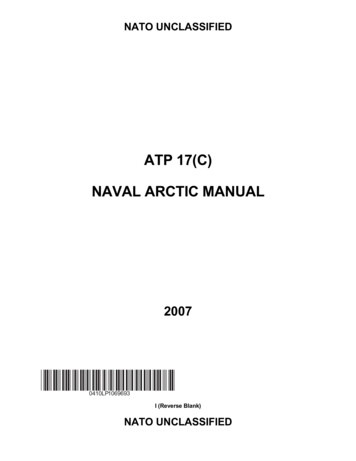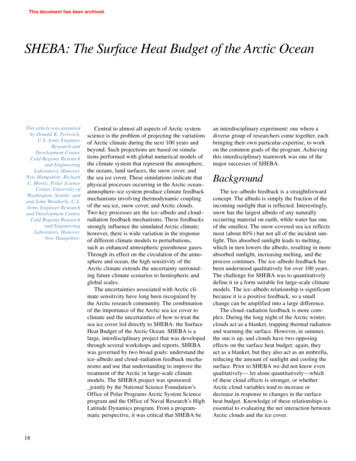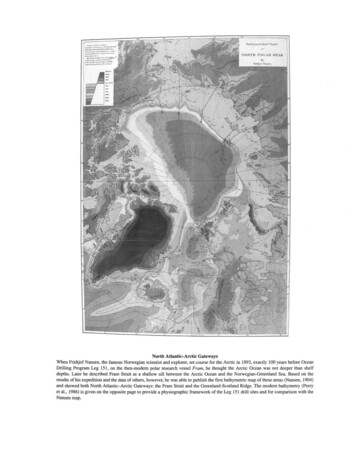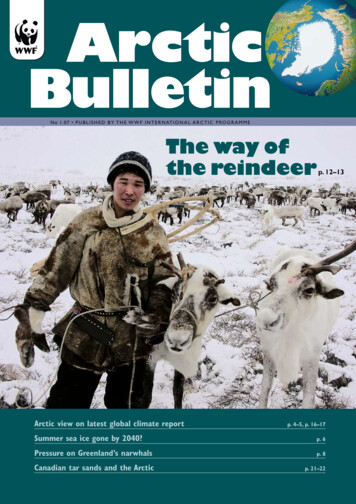
Transcription
ArcticBulletinN o 1 . 0 7 P U B L I S H E D B Y T H E W W F I nte r n ati o n a l AR C T I C P RO G RA M M EThe way ofthe reindeerArctic view on latest global climate report p. 12–13p. 4–5, p. 16–17Summer sea ice gone by 2040? p. 6Pressure on Greenland’s narwhals p. 8Canadian tar sands and the Arctic p. 21–22
W W F ARC T I C B U L L E T I N No. 1.07Contentsl Bush lifts drilling ban in Alaska’s Bristol Bay p. 11l Rapid climate change and the sea ice ecosystem p. 14–16Sustainable livelihoods in Kamchatka p. 12–13 ll Hunting of Chukotka’s polar bears? p. 9l Pipeline assessment must include how gas will be used p. 10l What in tar nation? p. 21–22l IPCC and the Arctic p. 4–5Ice-free arctic summers by 2040? p. 6–7 lWinter sea ice close to record low p. 6 ll Intense period of polar research p. 8l Populations of polar bear in decline p. 9l Interview: Arctic view on global climate report p. 16–17l Time for action p. 20–21Massive ice sheet breaks away p. 7 ll WWF and Canon join forces on Polar Bear Tracker p. 23l Greenland’s narwhals still in trouble p. 8l Whaling undermines whale watching in Iceland p. 18–19l WWF assists with Norwegian oil spill p. 10l New director for the WWFInternational Arctic Programme p. 6The Arctic Bulletinis published quarterly by the WWFInternational Arctic Programme.Reproduction and quotation withappropriate credit are encouraged.Articles by non-affiliated sources do notnecessarily reflect the views or policiesof WWF. Send change of address andsubscription queries to the address onthe right. We reserve the right to editletters for publication, and assume noresponsibility for unsolicited material.Please include name, title and, addresswith all correspondence.Publisher:WWF InternationalArctic ProgrammePO Box 6784St Olavs plassN-0130 Oslo, NorwayPh: 47 22 03 65 00Fax: 47 22 20 06 66Internet: www.panda.org/arcticProgrammeDirector:Neil Hamiltonnhamilton@wwf.noEditor:Nigel Allannallan@wwf.noAssociate editor:Emma DuncanDesign and production: Cover: A young man inFilm & Form/Ketill Berger Kamchatka learns how to herdreindeer as part of a WWFketill.berger@eunet.noproject to provide locals withsustainable livelihoods based onDate of publication:traditional lifestyles.February 1st, 2007Photo: Laura Williams,ISSN 1023-9081WWF-RussiaPrinted at Merkur-Trykk ASon 100% recycled paper.
WWF AR CTIC BUL L E T I N No. 1.07 EditorialA new age for the ArcticThe winds of change are blowing in the Arctic.Record after record is being ‘set’ as each newscientific paper catalogues decreases in ice area,ice thickness, and glacier melting, together withdramatic increases in temperature, river flow,and incidence of new southern species appearing athigher latitudes.Similarly, there is record public interest in theArctic as a result of the obvious impacts of climatechange. Newspapers all over the world have almostdaily coverage of yet another arctic ‘catastrophe’. Touse an Australian colloquialism: even Blind Freddycould not ignore what is happening!There are also significant shifts in the flavour ofarctic governance with the Arctic Council secretariat moving to Scandinavia and strongly renewedgeopolitical interest in the region from many of the‘great powers’. This is a new age for the Arctic, onein which the arctic nations, peoples, and organisations such as WWF can work together to create asustainable future – or an age in which change in theArctic results in a merciless rush to extract its finiteresources at the expense of the world.In such a dynamic context I feel quite humbledwriting my first editorial as director of the WWFInternational Arctic Programme following in thefootsteps of two highly experienced, committed, andsuccessful advocates for arctic conservation. Therespect and influence WWF enjoys in the regionis largely due to the efforts of Samantha Smithand Peter Prokosch, and those of their staff andcolleagues around the world.In spite of this work the necessity of achieving real,resilience-building outcomes in the Arctic is nowurgent and daunting. Much more than simply the‘canary in the coal mine’ of global climate change,the Arctic is the region where much of the world’sfuture may be decided over the coming decades. Thatfuture will focus on our response to human-inducedclimate change.The WWF Network and its partners are very wellplaced to shape the directions, decisions, and strategies that will be adopted.The process of shaping this future cannot just bebased on a continuation of past activities. The Arcticis now a global political issue and should remainone into the future. As I write, the Summary forPolicymakers of the IPCC Working Group II (Impactsand Adaptation) is being debated, with early draftsechoing what most of those with an ear to theground already know: we are seeing major changesin ecosystem structure and function in the Arctic as aresult of climate change, with global implications.The much talked about ‘positive feedbacks’ and‘thresholds’ may already be occurring. There isincreasing evidence of more rapiddisappearance of snow and sea icecover in some areas (e.g., Siberia,Alaska, the Greenland Sea) leadingto further climate change throughdecreased sunlight reflection (thealbedo effect) and insulation effects.The basic physics of the magnification of global temperature rises inthe Arctic (up to a factor of threeDr NeilHamiltontimes, but consistently double overDirector,the past several decades) indicateWWF Internationalthat enormous efforts are requiredArctic Programmein the Arctic and, more importantly,nhamilton@wwf.noaround the world.Beyond these effects, we mustnow also take seriously the potential for processes that were previously regarded asimprobable – including massive releases of methanefrom melting permafrost and currently solid depositson the seafloor – which would hugely increase theamount of this powerful greenhouse gas in theatmosphere.Such issues raise many challenges, not least theneed to engage even more strongly with the scientificcommunity, the nations who govern the region, thepeoples who live in and use the Arctic, and indeedthe wider global community.We need to think carefully about appropriateconservation strategies, governance regimes, andways to deal with the myriad of complex and interacting issues, often originating far from their pointsof impact. Importantly we need to learn to betterspeak many ‘languages’, including those of business, media, politics, and science, to communicatethe burning need for action. Practical solutions areneeded now at local and global scales and cannot beachieved by WWF alone.The intrinsic values of the Arctic and the immediate threats to these values and to the rest of theworld are sobering. However if we want to maintaina stable world, we have no alternative but to findsolutions. Together, let us make it happen in theArctic, and bring to life WWF’s slogan: For a LivingPlanet.
Climate ChangeCollege 2007Year two of the B&J’sClimate Change College (inwhich WWF is a partner)is under way, with sixambassadors chosen fromthe UK, Ireland, Netherlands,and Germany. The Collegeoffers 18–30 year oldsthe chance to educatethemselves about the causesand politics of, and potentialsolutions for, climatechange with an emphasis ondeveloping their own climatechange campaign. Each ofthe ambassadors is taskedwith using their personalexperience to reach a wideraudience. This could bethrough journalism, publicspeaking, or other kind ofevent. Their ultimate goal isto inspire carbon emissionsreductions as well as thetangible goal of signing up500 new e-campaigners forWWF. Read more aboutthe College as well as theambassador’s blogs at: www.climatechangecollege.orgOrcas attractedto warmer arcticwaters?Orcas (or killer whales)appear to be showing upin greater numbers andstaying longer in HudsonBay, Canada. Jeff Higdon,a graduate student at theUniversity of Manitobaworking with the federalDepartment of Fisheriesand Oceans, told Reuters:“For a number of years,Inuit hunters in the easternArctic have been reportingthat the number of killerwhales is increasing.” Thereason for their appearanceis still unknown, althoughHigdon noted that there wasa “significant correlation”between declining sea ice inHudson Bay and increasedrecorded sightings of orcas.Although orcas have oftenfrequented the waters ofHudson Bay, researchersand Inuit hunters are keento understand the recentincrease in sightings. Source:ReutersNews W W F AR C T I C B U L L E T I N No. 1.07IPCC and the ArcticThe latest report from the IntergovernmentalPanel on Climate Change (IPCC) presentsa dire outlook for the Arctic and the restof the planet unless something drastic isdone to curb greenhouse gas emissions.The IPCC report confirms much ofwhat is already known about the currentand projected impacts of climate change inthe Arctic. Over the last few decades, arcticsurface air temperatures have warmed ataround twice the global rate and majorecosystem shifts are beginning to be seenin areas such as the Bering Sea (see boxbelow).If climate change continues along thescenario trajectories projected by the IPCC,then some arctic species, especially the toplevel predators, could decline or disappearaltogether.IPCC experts state clearly that some climatechange is already unavoidable, but that thereis still time to protect against some of the mostdisastrous effects. This response must come aspart of a broad and rapid change of develop-Example climate change impacts in the Arctic*:Hudson Bay: fewer polar bear cubs Increased shoreline erosion already seen on ArcticOcean & Beaufort Sea coasts due to climate warming(1970–2000 relative to 1954–1970). The Arctic could change from a region thattraditionally stores greenhouse gases such as carbondioxide and methane, to a region that emits thesegases in vast quantities as its permafrost melts. InNorthern Siberia alone, methane emissions fromwetlands are estimated to increase by 10–63 percent.This methane source comprises a positive feedback toclimate change, as the thawing increases in responseto further warming.Nortern Siberia: methane emissions In both the Arctic and Antarctic, climate changewill lead to reduced habitat (including sea ice) formigratory birds and mammals, with major implicationsfor predators such as seals and polar bears that relyon sea ice for hunting. The condition of adult bears has declined in theHudson Bay region and first-year cubs come ashore inpoor condition. The number of cubs as a proportionof the population has also fallen as a result of the earlybreak-up of sea ice. The pole-ward migration of existing species andcompetition from invading species will continue to
News WWF AR CTIC BUL L E T I N No. 1.07ment strategies, looking to avoid continuedsignificant carbon dioxide emissions.Dr Lara Hansen, chief scientist in WWF’sGlobal Climate Change Programme, said:“The IPCC makes it clear that there is awindow of opportunity – but that it’s closingfast. The world needs to use its collectivebrains to think ahead for the next ten yearsand work together to prevent this crisis.”In the IPCC’s strongest conclusion yetregarding the cause of climate change, it saysthat it is 90–99 percent likely that climatechange is caused by humans.Sea ice retreating faster than IPCCmodels predictedA recent study by the National Snow andIce Data Centre (NSIDC) and the NationalCentre for Atmospheric Research (NCAR)concluded that satellite and other observations show that arctic ice cover is actuallyretreating more rapidly than estimated byany of the 18 computer models used by theIPCC in preparing its 2007 assessments.Mark Serreze, NSIDC scientist and coauthor of the study, said: “Our study indicates that the impacts of greenhouse gases onarctic sea ice are strong and growing.”See the back cover for a comparisonof actual observations versus the declinepredicted by IPCC models.Nigel Allannallan@wwf.noRead an interview with Dr Robert Corell, chair ofthe Arctic Climate Impact Assessment, on page 14-16Arctic ice retreatingalter species composition and abundance. Thesesouthern emigrants to the Arctic will also bring withthem new parasites and/or diseases to which arcticspecies are not adapted, thereby increasing mortality. Warming of areas of the northern polar oceanshas already had a negative impact on communitycomposition, biomass, and distribution ofphytoplankton and zooplankton (read the articleRapid climate change and the sea ice ecosystem onpage 14–16). Arctic glaciers will continue to retreat with aconsequent impact on global sea level.*Information from the IPCC Fourth Assessment Report’s Working GroupII (impacts, adaptation and vulnerability). A summary for policy makersof the science report from Working Group I (science of climate change)was released in February 2007 and the summary from Working GroupIII (mitigation of climate change) was released in May 2007. For moreinformation see: www.ipcc.ch Proposed pipelinecuts throughstruggling caribouherd’s rangeThe Mackenzie Valley PipelineJoint Review Panel was toldduring a hearing in Inuvik,Northwest Territories (NWT),Canada, that the proposedMackenzie Valley gas pipelinewould cut through the middleof the range of the CapeBathurst caribou herd. Theherd’s population has droppedalarmingly, from 17,500 in 1992to 1,800 in 2006. John Nagy,a biologist with the NWTgovernment, said: “The smallnumber of calves in early Julyindicates that few yearlingswill be recruited to theCape Bathurst herd in 2007.This suggests that a furtherdecline in the Cape Bathurst[herd] can be anticipated.”The Canadian governmentrecommends Imperial Oil, thelead partner in the pipelineproject, monitor the herds anddevelop a management plan.Source: Canadian BroadcastingCorporationBowhead sanctuarycreated butprotection neededfor narwhalA deal to create a sanctuaryfor bowhead whales in IsabellaBay, Nunavut, Canada, has beensigned between the Canadiangovernment and Nunavut’sland claim organisation. Localpeople have been seekingprotection for the area since1982. The deal now needsto be ratified by Inuit groupsand then signed off by theCanadian government. PeteEwins, species director atWWF-Canada, says the deal isan essential step but pointedout that there are many areasof Nunavut that still requireprotection, such as MilneInlet and Eclipse Sound inNorth Baffin, an importantnarwhal habitat, wherethere is increasing pressureto construct a year-rounddeepwater port to extract ironore. Nunavut’s caribou calvinggrounds are also threatened asthe area has been subject toheavy mineral staking. Source:Globe and Mail
News W W F AR C T I C B U L L E T I N No. 1.07Ice-free arcticsummers by 2040?and area are at a minimum. Toanalyse how global warming willaffect the ice in coming decades,the team studied a series of sevensimulations run on the NCARbased Community Climate SystemModel, one of the world’s leadingtools for studying climate change.The model results indicate that,if greenhouse gases continue tobuild up in the atmosphere at thecurrent rate, the Arctic’s future icecover will go through periods ofrelative stability followed by abruptretreat. For example, in one modelsimulation the September sea iceextent shrinks from about 5.9million to 2 million square kilometres (2.3 million to 770,000 squaremiles) in a 10-year period.In this model run only a smallamount of perennial sea iceremains along the north coasts ofUCARUnless greenhouse gas emissionsare significantly reduced therecent retreat of arctic sea iceis likely to accelerate so rapidly thatas early as 2040, the Arctic Oceancould become nearly devoid of iceduring summer.This is the conclusion of astudy conducted by scientistsfrom the US National Center forAtmospheric Research (NCAR),the University of Washington, andMcGill University. By runningmodel simulations on supercomputers, the team showed that theextent of sea ice each Septembercould be reduced so abruptly that,within about 20 years, it may beginretreating four times faster than atany time in the observed record.Arctic sea ice has retreatedin recent years, especially in thelate summer when ice thicknessSummer arctic sea ice extent: 2000Greenland and Canada by 2040,while most of the Arctic Basin isice-free in September. Winter icealso thins from about 3.6 metres(12 feet) thick to less than onemetre (3 feet).The scientists also concludedWinter sea ice close to record lowNational Snow and Ice DataCentre (NSIDC) scientistsannounced that the maximumextent of arctic sea ice in winter2007 was the second-lowest in thesatellite record, narrowly missingthe March 2006 all-time lowestrecord.Sea ice extent, or the area ofocean that is covered by at least 15percent ice, was 14.7 million squarekilometres (5.7 million squaremiles) for March 2007, comparedwith 14.5 million square kilometres (5.6 million square miles) forMarch 2006, the current lowestrecord. The long-term monthlymean for March sea ice extent from1979 to 2000 is 15.7 million squarekilometres (6.1 million squaremiles).Scientists monitor arctic sea iceyear-round, paying special attention to its extent during March andNew director for the WWF International Arctic ProgrammeDr Neil Hamilton is the newdirector of the WWF InternationalArctic Programme. A geographerby training, Neil has more than 15years experience in the strategicdevelopment and leadership ofnational and international globalchange programmes on issuessuch as climate, the carbon cycle,water management, marine andbioregional planning and foodsecurity.Neil said: “The next ten yearswill seal the fate ofthe Arctic. Either itwill be the victim ofhuman greed andignorance or theshining exampleof what can beachieved through collective effortto find real solutions.“The WWF International ArcticProgramme works across the entireregion to find those solutions inconcert with the WWF networkand our partners in a way that noother body, official or otherwise,can or does. The role we playtherefore is critical to the future ofthe Arctic. That’s quite a responsibility to take on. I’m confident thatwe can collectively find those solutions and help implement them.”Neil left his position as Directorof FEAST, a European Union/Australian funded initiative onscience and technology cooperationin Canberra, Australia.September. March usually marks theend of winter in the Arctic, a periodwhen sea ice grows, or recovers,from the summer minimum.Low winter recovery meansthat the ice is forming later in theautumn and growing at a slowerpace during winter.September usually marks theend of the summer melting season;low summer extent means that seaice is melting faster during summer,leaving less ice to build on duringwinter recovery.Walt Meier, NSIDC scientist,said: “This year’s low wintertimeextent is another milestone in astrong downward trend. We’restill seeing near-record lows andhigher-than-normal temperatures.We expect the downward trend tocontinue in future years.”Nigel Allannallan@wwf.no
News WWF AR CTIC BUL L E T I N No. 1.07 Summer arctic sea ice extent: projected for 2040that if emissions of carbon dioxideand other greenhouse gases were toslow, the likelihood of rapid ice losswould decrease. Instead, summersea ice would probably undergo amuch slower retreat.Marika Holland, NCAR scientistand the study’s lead author, said:“Our research indicates that societycan still minimise the impacts onarctic ice.”The study was published inthe December 12, 2006 issueof Geophysical Research Letters.Animated simulations can beviewed at: lNigel Allannallan@wwf.noSource: NCARBy 2040, the Arcticmay be nearly devoidof sea ice during thelate summer unlessgreenhouse gas emissions are significantlycurtailed.Massive ice sheetbreaks awayIn December 2006, after piecingtogether evidence from seismicreadings and satellite images,scientists revealed that a giantice shelf had broken away in theCanadian High Arctic.A huge section of Ayles Ice Shelfon Ellesmere Island in Nunavut,Canada, broke away and floatedout to sea on13 August 2005.According to news reports, thebreak took less than an hour, andDr Luke Copland, director of theUniversity of Ottawa’s Laboratoryfor Cryospheric Research, describedthe break as evidence of the Arctic’srapid response to warming temperatures.Dr Copland said: “Since 1900,approximately 90 percent of theEllesmere Island ice shelves havecalved and floated away. This is aone-way process as there is insufficient new ice formation to replacethe ice that has been lost.“The Ayles calving event wasthe largest in at least the last 25years; a total of 87.1 square kilometres (33.63 square miles) of icewas lost in this event, of whichthe largest piece was 66.4 squarekilometres (25.64 square miles) inarea. This piece is equivalent in sizeto approximately 11,000 footballfields or a little larger than the cityof Manhattan.”More information: www.ice.ec.gc.ca/app/WsvPageDsp.cfmNigel Allannallan@wwf.noSource: NASA, Canadian Ice Service &University of Ottawa
News W W F AR C T I C B U L L E T I N No. 1.07Intense periodof polar researchTof saving this planet from someof the major destructive forces itis facing.“With more solid documentation and systems for understandingthe functions and dynamics of thepolar ecosystems, we will havemuch better tools and information for backing up WWF’s workon securing the future for theseincredibly important regions, andfor the global processes they sostrongly influence.”WWF has been working closelywith, and also funding the work of,a number of the scientists who willbe leading core IPY initiatives. Weare also directly involved in severalof the field projects being implemented under IPY.Pete Ewins, species conservationdirector for WWF-Canada, said:“IPY only happens every 50 yearsor so, and the original intent wayback in the 19th century – betterintegrated and focused scientificresearch in polar regions – is arguably even more pressing today thanit was then.”Nigel Allannallan@wwf.noGreenland’s narwhals still in troubleNThor Hjarsen/www.ecoadvise.dkNarwhal quotas inGreenland continue toexceed recommendedsustainable levels.he 2007–08 InternationalPolar Year (IPY), a period ofintense study on the Arctic andAntarctic, officially began on 1March 2007 with numerous ceremonies taking place around theworld.The official opening ceremonytook place at the Palais de laDécouverte, a renowned sciencemuseum in Paris, France.The IPY represents one of themost ambitious coordinated international science programmes everattempted, with over 60 countriesparticipating in more than 200projects, over 50 of which focus oneducation and outreach.The poles are recognised assensitive barometers of environmental change and IPY researcherswill explore the strong links theseregions have with the rest of theglobe. Polar science is crucial tounderstanding our planet and ourimpact on it.Stefan Norris, head of conservation for WWF’s International ArcticProgramme, said: “For WWF, theIPY presents a unique opportunityto pool resources towards the goalarwhal hunting inGreenland continues atlevels significantly higherthan the recommended sustainable level set by the NorthAtlantic Marine MammalCommission (NAMMCO) of135 whales annually.NAMMCO has previouslyexpressed grave concern aboutthe apparent decline of narwhaland beluga stocks in WestGreenland. While the commission commended Greenlandfor the recent introduction ofquotas, it is still very concernedthat present takes of narwhalsand belugas in West Greenlandwill lead to further depletion ofthe stocks.WWF previously reportedon the increase of the Greenlandhunting quota for the 2005–06hunting season from 260 to310 narwhals following twoillegal hunting events in WestGreenland (see Arctic Bulletin01.06).For the 2006–07 huntingseason, the quota was furtherincreased to a record 385narwhals – almost three timesthe recommended sustainablehunting level.Back in 2004 when thequota system was introduced,the Greenland governmentpromised to reduce huntingpressure.Greenland did enforce avoluntar y ban in 2006 onexport of all narwhal products,including tourist souvenirs.This came after a EuropeanUnion import ban on narwhalproducts and after increasingpressure from the Conventionon International Trade inEndangered Species of WildFauna and Flora (CITES).Thor Hjarsen, M. Sc.EcoAdvise & Communicationecoadvise@ecoadvise.dk
News WWF AR CTIC BUL L E T I N No. 1.07Populations of polarbear in declineAdult polar bear walkingthrough semi-frozen seawater, known as “greaseice”. Hudson Bay, Canada.Bryan & Cherry Alexander Photography, www.arcticphoto.co.ukFive of the 19 polar bear subpopulations in the world arein decline, an indication thatthe entire Arctic ecosystem isunder immense stress as a result ofclimate change.With the Arctic warming at morethan twice the rate of the rest of theworld, and sea ice over the Arcticprojected to disappear in summerbefore the end of this century (seeIce-free arctic summers by 2040?on page 6–7), polar bears – whichdepend on sea ice to live, hunt, andbreed – face serious trouble.Stefan Norris, head of conservation for the WWF InternationalArctic Programme, said: “The polarbear’s powerful grip on the Arctic isslipping.“We need to stop run-awaywarming. Climate change is meltingthe ice-bear’s toe-hold on life. Thisbad news for polar bears is also badnews for other arctic species, andfor the indigenous peoples whosetraditional ways of life depend onthem.”According to a newly publishedreport by the World ConservationUn i o n’s ( I U C N ) Po l a r B e a rSpecialist Group (PBSG), thetwo best-studied polar bear sub-populations, the western HudsonBay population (Canada) and thesouthern Beaufort Sea population(US/Canada), have declined by 22percent and 17 percent, respectively, over the past two decades.The other three sub-populations in decline are those in BaffinBay and Kane Basin (Greenland/Canada) and Norwegian Bay(Canada).The PBSG report also documents incidents of drowned polarbears and cannibalism, as well asincreased numbers of ‘problem’bears (bears looking for food neararctic communities) in many areas.These observations are consistentwith predicted changes caused byclimate warming.The report’s findings havepromp te d WWF to issue anurgent call to action to the world’sgovernments to cut carbon dioxideemissions, the cause of dramaticwarming in the Arctic.Alison SuttonSenior Press Officer,WWF-UKasutton@wwf.org.ukRead the feature Time for action on polarbears on page 20.Hunting of Chukotka’s polar bears?After six years of negotiations,in December 2006 the USCongress passed the implementing legislation needed fora US-Russia agreement on theconservation and usage of theChukotka-Alaska polar bear subpopulation.This agreement may allowlimited hunting of polar bears, butWWF believes that serious monitoring should take place prior toany hunting.Viktor Nikiforov, WWF-Russia’sregional programmes director, said:“For the first time since 1956, whenhunting for polar bears was strictlyprohibited in Russian territory,limited hunting for polar bearsmay be allowed.“At present the Chukotka-Alaskasub-population of polar bears isin a tough situation because ofglobal warming. It is necessary toorganise intense monitoring of thesub-population before starting tohunt for polar bears.”After ratification of the agreement, a committee on polar bearconservation will be organised.Two commissioners from eachparty, Russia and the US, will bethe representatives of indigenouspeople and governments.Russia will be represented by theMinistry of Nature Resources ofthe Russian Federation, and the USwill be represented by the US Fishand Wildlife Service.At the first meeting, the commissioners should develop a list ofrecommendations, including keyissues devoted to conservation andusage of the polar bear sub population, hunting limits, and the periodof any hunting season.Viktor Nikiforov,Regional Programmes DirectorWWF-Russiavnikiforov@wwf.ru
News 10W W F AR C T I C B U L L E T I N No. 1.07Pipeline assessment mustinclude how gas will be usedEnvironmental groups representing millions of NorthAmericans are calling on theJoint Review Panel (JRP) for theMackenzie Gas Project to consider,as an integral part of the project,how the gas carried by the pipelinewould be used.WWF-Canada has asked thePanel to consider end-use scenariosand thus address the project’s fullimpact, including global warmingimpacts from all end products.The project, backed with billionsof dollars from big oil and Canadianfederal and territorial governments,would trigger the petro-industrialisation of Canada’s North,destroy parts of the region’s borealforest, and power greenhouse-gasintensive projects such as furtherdevelopment of Alberta’s tar sands,which fuel North America’s carsand trucks (see Connected to theArctic: What in tar nation? on page21–22).Pipeline proponents continueto dispute a link between the gas,to be extracted from the BeaufortSea, and the tar sands.However the Sierra Club ofCanada has obtained new maps,which indicate that a direct interconnection is planned. The organisation insists the JRP must assessglobal warming and other impactsassociated with using gas carriedby the Mackenzie Gas Pipeline toproduce the most carbon-intensiveoil on the planet.With the US as a major marketfor Canadian energy, US groupshave been closely following thehearings as well.The organisations have notedthat only one-third of the gasfields needed to provide gas for thepipeline has been included in theenvironmental assessment for theproject.It is particularly unbalancedto exclude the development andglobal warming impacts of theother two-thirds of the gas since theproject’s proponents have countedtheir economic benefits.The JRP hearings on cumulativeeffects, and project sustainabilityand alternatives, have yet to bescheduled. It is expected that thesevital topics will be covered laterthis year, and that the JRP’s finalreport and recommendations willbe submitted by December 2007.Julia LangerDirector, Global ThreatsWWF-Canadajlanger@wwfcanada.
Arctic Bulletin No 1.07 PUBLISHED BY THE WWF INTErNaTIoNaL arCTIC ProGraMME Arctic view on latest global climate report p. 4-5, p. 16-17 Summer sea ice gone by 2040? p. 6 Pressure on Greenland's narwhals p. 8 Canadian tar sands and the Arctic p. 21-22 The way of
